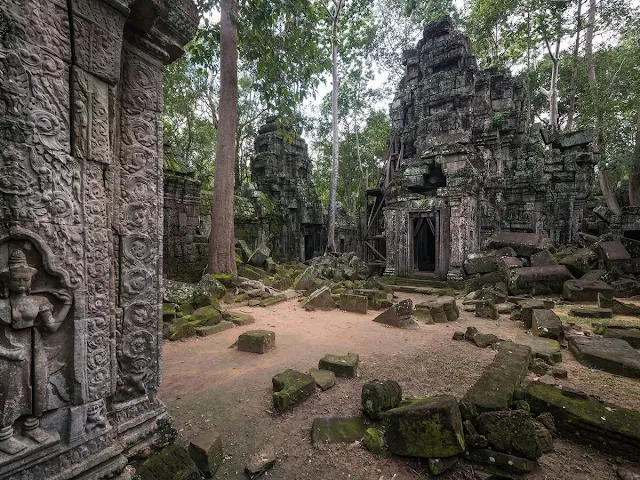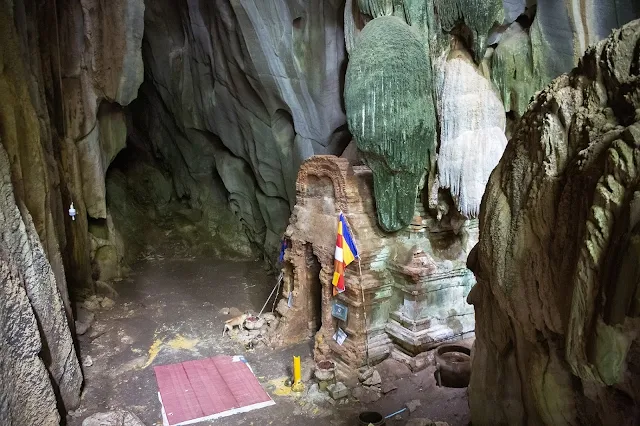4 Hidden Secrets of Cambodia’s Temples
4 Hidden Temples in the Cambodian Jungle
Deep within the lush jungles of Cambodia, beyond the well-trodden tourist paths of Angkor Wat, lie ancient and mysterious temples that have been swallowed by nature and nearly forgotten by time. These hidden temples are not only stunning architectural marvels but also steeped in eerie legends, spiritual beliefs, and baffling historical mysteries. While millions visit Cambodia each year, only a few adventurers ever lay eyes on these secluded gems, each with its own strange story to tell.
In this article, we explore four of Cambodia's most unique hidden temples, revealing their odd characteristics, ancient secrets, and the legends that surround them. These sites offer a glimpse into a forgotten spiritual world and prove that Cambodia's mystical history runs far deeper than Angkor Wat alone.
1. Prasat Chhngauk: The Temple with a Cave Beneath
Located near the foot of Phnom Chhnork in Kampot Province, Prasat Chhngauk is a small pre-Angkorian Hindu temple dating back to the 7th century. What makes this temple so strange is that it's built directly on top of a limestone cave system. You won’t find crowds here — only bats, whispering winds, and the soft hum of jungle life.
Strange Features
- Cave shrine: Inside the cave, Hindu carvings remain intact, including a well-preserved Shiva lingam, symbolizing divine generative energy.
- Echoes and voices: Locals believe the cave speaks at night. Echoes bounce in unnatural ways, giving the impression of whispers and chants.
- Unusual orientation: The temple’s southern-facing entrance goes against traditional east-facing Khmer structures. Some believe it’s aligned with solar events tied to local rituals.
Legend has it that a spirit guardian lives in the cave and protects the temple. Offerings of incense and flowers are still left at the cave’s mouth, and the brave few who venture deep inside often emerge with tales of glowing orbs and sudden changes in temperature.
2. Beng Mealea: Cambodia’s Real-Life Jungle Temple
Beng Mealea, located about 40 kilometers east of Angkor Wat, is a massive 12th-century temple that has been nearly consumed by the jungle. Massive tree roots burst through sandstone walls. Entire corridors have collapsed under centuries of growth. This untouched atmosphere has earned Beng Mealea the nickname "The Lost Temple."
Fascinating Facts
- Unknown dedication: While built in the same era as Angkor Wat, no definitive deity has been linked to Beng Mealea. Its inscriptions are too weathered to decipher.
- Movie-like setting: Beng Mealea was a filming location for adventure movies due to its overgrown, eerie beauty.
- Root entrapment: Trees like strangler figs and kapok wrap their roots around the temple as if trying to reclaim it for the jungle.
The temple was once part of a greater city, now lost under vegetation. Archeologists using LiDAR have found hidden structures buried around Beng Mealea, including ceremonial roads and water systems. Some believe a secret underground passage connects it to Angkor Thom, though no conclusive proof has been found.
Visitors often describe a powerful energy emanating from the site — a mix of awe and discomfort. The eerie silence, broken only by chirping cicadas and the sound of falling leaves, reinforces the idea that the jungle itself has taken back its temple.
3. Koh Ker: The Pyramid Temple Forgotten by Time
Far off the beaten path in northern Cambodia lies Koh Ker, once the capital of the Khmer Empire in the 10th century. This temple complex features over 180 structures, though most are crumbling and overtaken by forest. Its centerpiece is the bizarre step pyramid known as Prasat Thom — a 36-meter-high temple mountain unlike anything else in Southeast Asia.
Unique Highlights
- Pyramid design: With seven levels and steep stone staircases, Prasat Thom resembles Mayan architecture more than typical Khmer temples.
- Enigmatic deity: It was built under King Jayavarman IV, who worshipped the Hindu god Treypuvanesvara, a form of Shiva never again referenced in Khmer texts.
- Cursed ground: Local myths say a guardian naga spirit protects the temple, and trespassers risk being followed by misfortune.
Due to its location in an area once heavily mined during Cambodia's civil war, Koh Ker was inaccessible for decades. Even today, only a fraction of the complex has been fully explored. Satellite imagery and ground radar suggest vast underground vaults lie beneath the pyramid — untouched and possibly containing royal relics or ritual objects.
The pyramid’s summit offers a stunning view of endless jungle, but reaching the top is not for the faint of heart. Some climbers claim to feel a strange heaviness or pressure on the chest while ascending — an experience attributed to the site's spiritual energy or perhaps its dizzying history of blood and devotion.
4. Phnom Kulen’s Reclining Buddha Temple
Phnom Kulen is a sacred mountain range considered the birthplace of the Khmer Empire. Atop its peak is the hidden Preah Ang Thom temple, home to Cambodia’s largest reclining Buddha statue, carved directly from a sandstone rock. The site is both visually stunning and spiritually charged.
Strange and Sacred Aspects
- Integrated sculpture: The 17-meter-long Buddha is not assembled, but sculpted in place from the mountain itself — a feat of devotion and engineering.
- Healing springs: Beneath the temple flows a sacred stream known as Kbal Spean, carved with hundreds of lingas and believed to purify all water downstream.
- Vanishing trails: Locals claim paths to the temple appear and disappear with the seasons. Some who stray off-trail report getting “lost for days” even when near villages.
Preah Ang Thom is visited by thousands of pilgrims every year during Khmer New Year and Pchum Ben, Cambodia’s ancestor festival. Offerings are made not just to Buddha, but also to spirits of the forest who are believed to dwell nearby. Some visitors report hearing soft gongs and chanting at night, despite no monks being present.
Legend has it that King Jayavarman II declared Cambodian independence from Java on this very mountain, performing a Hindu ritual that declared him a universal monarch — the Devaraja. This adds a powerful historic resonance to the otherwise tranquil site.
Why These Hidden Temples Are So Unusual
Each of these hidden temples challenges conventional ideas about ancient Khmer architecture and spirituality. Their odd layouts, unknown dedications, and remote locations suggest that these were not ordinary state temples but sacred places for elite rituals, secret ceremonies, or ancient cult practices. They also reveal the Khmer Empire’s wide range of beliefs, from Hinduism and Mahayana Buddhism to folk animism.
Furthermore, these temples share a strange relationship with nature. Instead of resisting the jungle, many of them were built to incorporate it. Trees grow through shrines, rivers flow through sanctuaries, and mountains become parts of temples themselves. This union of man, spirit, and nature is part of what makes these places so enigmatic and beautiful.
Modern Efforts to Preserve the Mystery
Thanks to efforts by the Cambodian government and UNESCO, some of these remote temples are now protected and slowly being studied. However, preservation often takes a backseat to tourism in more popular areas, leaving hidden temples vulnerable to erosion, looting, and environmental decay. Some archaeologists argue that these temples should remain "untouched" to preserve their mystery and authenticity.
There’s a growing trend in sustainable tourism encouraging travelers to visit such places respectfully, guided by local experts and without disturbing the delicate balance of their spiritual ecosystems. Guided jungle hikes, local village homestays, and conservation-led trips now allow modern adventurers to experience these sacred places ethically and meaningfully.
Visiting Tips for Jungle Temples
If you plan to discover Cambodia’s hidden temple treasures, keep these tips in mind:
- Use a local guide: Trails can be dangerous and hard to follow. Guides also share local myths and insights you won’t find in guidebooks.
- Travel during the dry season: Monsoon rains can make jungle paths muddy and rivers impassable.
- Respect sacred spaces: Dress modestly, remove shoes when appropriate, and never climb statues or altars.
- Bring offerings: Incense, candles, or flowers are appreciated at many active shrines.
- Leave no trace: Take only photos, and leave nothing behind but footprints.
Conclusion
The Cambodian jungle holds secrets that even time has not entirely erased. From temples built atop caves and pyramids lost in overgrowth to statues carved from living rock, these sites are a testament to the strange beauty of ancient belief systems. They offer more than a glimpse into history — they invite us to connect with something timeless and sacred. For those drawn to the mysterious and the unique, these four hidden temples represent the ultimate journey into the unknown heart of Cambodia.
Haruka Cigem - Curious Facts Explored.





Post a Comment